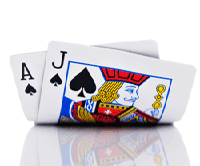Blackjack Advantage Play
 Everyone likes to have an edge, including blackjack players. Playing blackjack by using just basic strategy is great, but that does leave the casino with a small house advantage. This edge is usually under 1%, but in the long run, even that small edge is enough to guarantee that the house is going to come out ahead against you.
Everyone likes to have an edge, including blackjack players. Playing blackjack by using just basic strategy is great, but that does leave the casino with a small house advantage. This edge is usually under 1%, but in the long run, even that small edge is enough to guarantee that the house is going to come out ahead against you.
With that in mind, serious blackjack players are always looking for ways to take the advantage away from the casino and put themselves on top. Blackjack advantage play can be achieved in a number of different ways, though many casinos have put into place practices designed to combat these techniques. Here’s a rundown of some of the most common ways players can look to get an advantage at blackjack.
Card Counting
The most well known – if badly understood – blackjack advantage play is card counting. Over the years, card counting has gained a level of mystique, thanks to portrayals in television and movies that have made it seem like a sure-fire path to riches, though one only available to savants.
In reality, card counting is difficult, but something that anyone should be able to master if they’re willing to put in the work. Card counting works because of two principles. First, as cards are dealt from a blackjack shoe, the remaining cards in the shoe become non-random; since we know which cards were removed, we also know which cards are still waiting to be dealt. Secondly, some cards are better for the player than others; tens and aces are favorable for the player, while low cards, especially fives, hurt the player’s chances significantly.
This means that when there are many tens and aces left in the shoe, but few small cards, the player is playing at an advantage over the casino. Conversely, a shoe rich in small cards is one that’s very bad for the player.
Card counters can take advantage of this fact by wagering more money when the shoe is advantageous for the player. The count can also help card counters make plays not normally used by players just using basic strategy, such as taking insurance when the odds favor doing so.
Read More on Card Counting
Shuffle Tracking
While card counting is the most well-known and popular blackjack advantage play, there are other techniques that, when done properly, can be just as – or more – effective. One such technique is shuffle tracking, where players track where cards are as they are being shuffled.
Shuffle tracking is typically used along with card counting to gain an even larger advantage. First, players break the shoe into subsections, each of which gets their own individual count along with the overall shoe count. If the count in a small area of the shoe turns out to be very high, then that section of the discarded cards is ripe for tracking. A player can now attempt to track those cards when the decks are reshuffled into a new shoe.
Because a large six or eight deck shoe is sometimes shuffled rather simply due to the large number of cards, this makes tracking groups of cards possible. The player can then ut in such a way as to keep that group of cards close together, and bet more when those cards are about to be dealt, knowing that they are advantageous to the player.
Of course, shuffle tracking – like card counting – can be thwarted by a continuous shuffling machine. However, shuffle tracking is also difficult or impossible when cards are machine shuffled, or even meticulously shuffled by hand. This makes finding situations where shuffle tracking can work somewhat more difficult to find than with card counting. However, if the shuffle can be tracked well, then the rewards are potentially much greater.
Other strategies related to shuffle tracking include ace sequencing, in which players attempt to track when aces will appear, and card steering, in which the location of a specific card is known, and the player can try to “steer” it towards their hand, or the dealer’s.
Hole Carding
In hole carding, a player attempts to see what the dealer’s hole card is at the beginning of the hand, before they have to make their own decisions about their hand. Obviously, knowing the dealer’s hole card is a huge advantage; in fact, a player who played optimally with knowledge of every dealer hole card would be playing with an amazing advantage of around 13%! Of course, that would lead to the player getting caught more often than not; it’s unlikely that you’ll want to be hitting with a hard 18 against a dealer 19, unless you want to be barred from playing blackjack.
There are several different techniques used to determine the dealer’s hole card. One early strategy was to try to sneak a peak at the card when the dealer checked for blackjack if they were showing a ten or an ace. Of course, this limited the number of opportunities for the player to gain information. More recently, the development of electronic devices that can check for a blackjack have made these techniques mostly obsolete.
Another method is known as front-loading. This technique requires the player to attempt to spot the hole card as it is slipped underneath the up card. Players may also try to get a glimpse of the hole card by carefully watching the card as the dealer first places it on the table. All of these techniques can promise great rewards, but depend heavily on how sloppy the dealer is when dealing cards. A skilled dealer may virtually never allow any players a look at the hole card, while a less experienced dealer might give away information quite frequently.


















